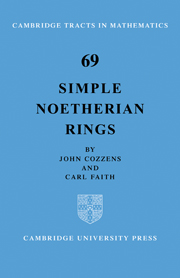Book contents
Introduction
Published online by Cambridge University Press: 29 October 2009
Summary
In this book we have collected the known theorems on the structure of simple right Noetherian rings, and more generally for simple rings containing a uniform right ideal U. By the Goldie and Lesieur–Croisot theorems, any prime right Noetherian ring R has a simple Artinian ring Q(R) of right quotients. By the Artin–Wedderburn theorem, Q(R) is isomorphic to a full n × n matrix ring Dn over a (not necessarily commutative) field D. Moreover, the endomorphism ring B of any uniform right ideal U of R is a right Ore domain with right quotient field Q(B) ≈ D.
The Goldie and Lesieur–Croisot theorem is historically the first representation of a right Noetherian non-Artinian prime ring in a matrix ring of finite rank with entries in a field. (The Chevalley–Jacobson density theorem for a primitive ring R yields a representation by infinite matrices over a field unless R is Artinian.)
Significant simplifications in, and additions to, the Goldie and Lesieur–Croisot theory occur if R is assumed to be a simple ring. Henceforth R will denote a simple ring with identity element, and uniform right ideal U as described. We now outline the structure theory for R, which includes that for a simple right Noetherian ring.
Endomorphism ring theorem 2.17
Every simple ring R with uniform right ideal U is the endomorphism ring, R ≈ End BU canonically, of a torsion free module (= U) of finite rank over a right Ore domain B (Faith).
Projective module theorem 2.17
U is a finitely generated projective left B-module, where B = End UR (Hart).
- Type
- Chapter
- Information
- Simple Noetherian Rings , pp. 1 - 7Publisher: Cambridge University PressPrint publication year: 1975
- 1
- Cited by



